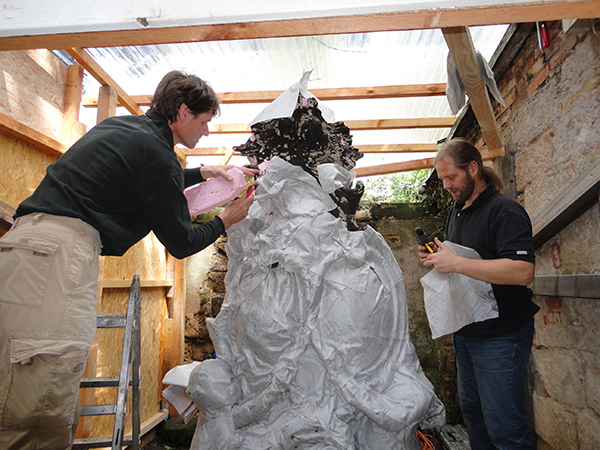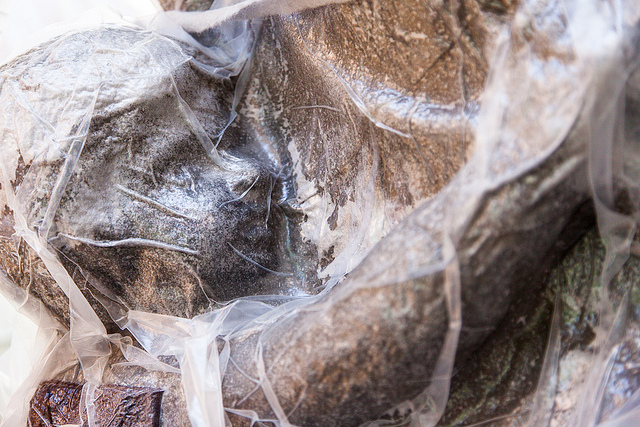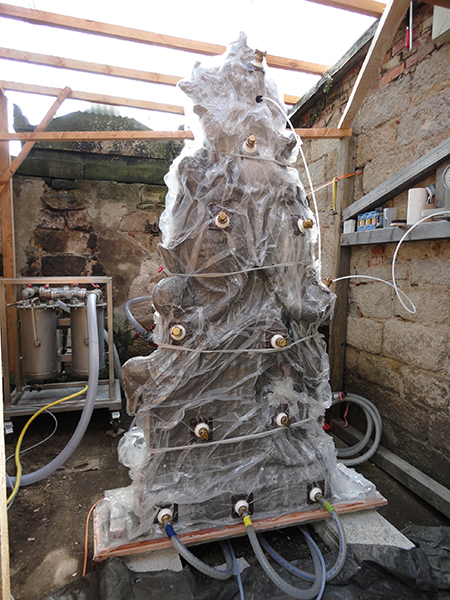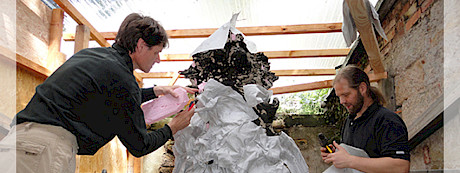The cleaning power of water
24/07/2013
DBU Project Dresden – Sponsorship project of "German Environment Foundation 2013" "Innovative method to strengthen complicated preservable environmentally damaged sandstone monuments and numeric geomechanic simulation of the risks"
At the "Neustädter" cemetery in Dresden a baroque tombstone, made from Cottaer sandstone, was selected to desalinate it with the VAC method and after an appropriate time of drying, to strengthen and preserve it with ethylsilicate by the VAC technique.
project partner:
- Landesamt für Denkmalpflege Sachsen - Dr. Arndt Kiesewetter Schloßplatz 1 - 01067 Dresden
- Amt für Kultur und Denkmalschutz Dresden - Frau Christine Spitzhofer Königsstr. 15 - 01097 Dresden
- Stadtverwaltung Dresden, Amt für Stadtgrün und Abfallwirtschaft - SG Allgemeines Friedhofswesen - Frau Katja Porrmann Grunaer Str. 2, 01069 Dresden
- Atelier Erich Pummer GmbH - Erich Pummer Nr. 165 - A 3602 Rossatz
- Dipl.-Rest. Michael Eilenberger Muldentalstr. 61 09623 Rechenberg-Bienenmühle, Holzhau
- Ev.-Luth. Neustädter Friedhofsverband - Herr Wolfgang Mehmke Friedensstr. 2 - 01097 Dresden
The VAC method will be presented to restorers, personnel of monument care and cemetery administrators in the scope of a colloquium. The expected positive results of this project will give an essential impact to prospective stone conservation projects and will also generally promote the preservation of stone monuments.
The Cotta Sandstone is popular among sculptors because of its easy formability. But just as it has fine granularity, fine pores and the clay component, which conjures up the marble-like texture in the stone, this also penalizes it: Entering rain water remains inside, it then sucks towards the clay and causes damage. "Cotta sandstone", says Prof. Heiner Siedel of the TU Dresden, "is the main patient of the sandstone care in Saxony."

Within a project of the German Federal Environmental Foundation the patient will now be preferably better helped than before. The Institute of Geotechnical Engineering of the Bergakademie Freiberg and TU Dresden, with the help of a specialist from Austria, takes on the matter: Those from Freiberg in a rather theoretical way by creating modellings with the computer, which should lead to reliable predictions in the long term - and those from Dresden together with the Austrians on the practical model.
This is a late baroque tomb with two Putti vases and extensive drapery, standing on the inner Neustädter Cemetery. The cemetery was founded in 1731 outside the former city walls. Today it is inside, surrounded by the old gas works and Gründerzeit quarters. It is one of the cemeteries with the most baroque tombs in Saxony with 17 baroque crypt houses and several memorable tombs.
In a first phase, the tomb is desalted, in a second one it is impregnated. The applied technique is new to the Dresden preservationists, for the Atelier Erich Pummer from Wachau, Lower Austria it has already been a proven business model: The Vacuum Consolidation, developed and patented throughout Europe by the Austrian restoration company, operates with a lot of water and vacuum. The water washes away the salts - but unlike traditional methods, the vacuum ensures that this effect does not remain superficial. How deep you penetrate into the depth of Cotta sandstone, is one of the questions to be accurately scientifically studied.

The selected property is ideal for research: Due to environmental influences it has already been destroyed to such an extent, that the preservationists can't save it using conventional methods. Better off acquiring new knowledge and also by carefully taking material samples before, during and after the conservation process – apply it!
6,000 liters of water flow into the vacuum which then penetrates deeply into the sandstone. What is then flushed out, initially contains a lot of salt which decreases, as during the process there is a constant performed measurement of the water conductivity signals. In October, the tomb is then wrapped up a second time. At this point it is not rinsed with water anymore, but with vacuum ethyl silicate as a preservative.
What exactly happens during each phase is what the researchers want to find out throughout the exact analysis of samples - for the first time it is profitable for this technique and, so it works, also for the monument preservation.
